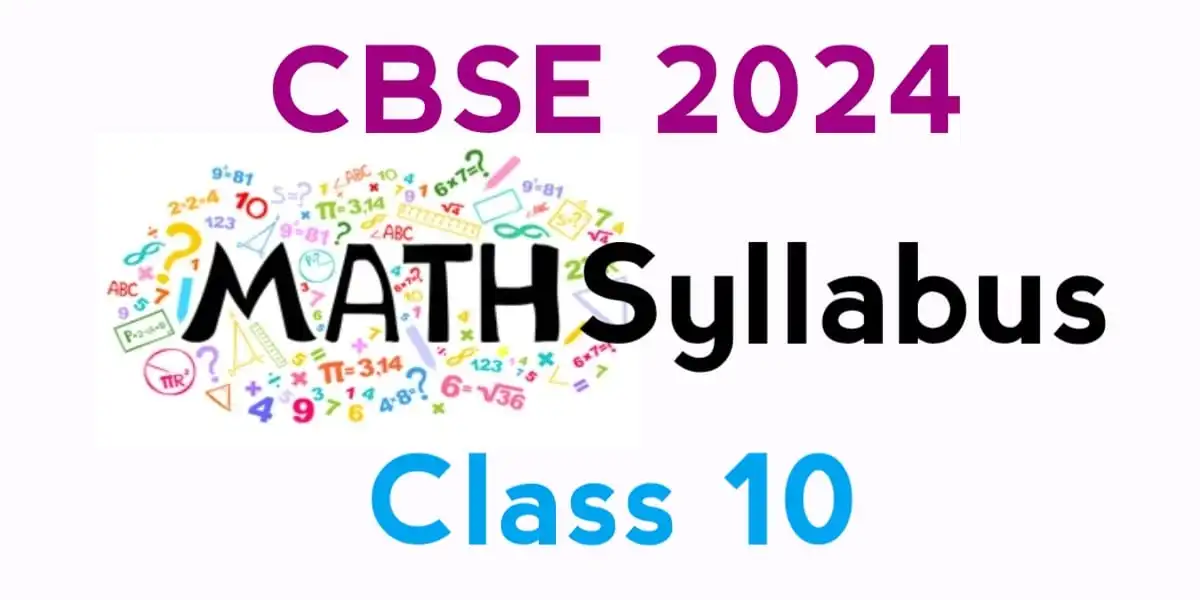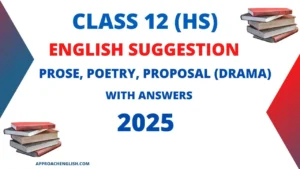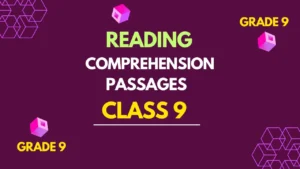Explore the updated CBSE Mathematics Syllabus for Class 10 (2023-24), designed for practical learning and real-world applications that have been published by the Central Board of Secondary Education (CBSE).
The Central Board of Secondary Education (CBSE) is continually evolving its syllabus to keep pace with the changing educational landscape. The CBSE Mathematics Syllabus for Class 10 in 2023-24 is no exception.
It focuses on equipping students with essential mathematical knowledge and skills, ensuring they are well-prepared for their future academic and professional endeavors.
CBSE Class 10 Mathematics Syllabus 2023-24
CBSE is set to introduce significant changes in the Mathematics syllabus for Class 10 in 2023-24. INow, we will delve into the details of these modifications, providing students, parents, and educators with a clear understanding of what to expect.
This article provides a complete syllabus for the CBSE Class 10 Maths Exam 2023-24, which can be downloaded in PDF from the provided link. Students can also download essential resources for preparation. Let’s begin by providing an overview of the Class 10 Mathematics Syllabus for 2023-24.
Related Topic
CBSE Course Structure for Class 10 Mathematics Syllabus 2023-24
| Units | Unit Name | Marks |
| I | NUMBER SYSTEMS | 06 |
| II | ALGEBRA | 20 |
| III | COORDINATE GEOMETRY | 06 |
| IV | GEOMETRY | 15 |
| V | TRIGONOMETRY | 12 |
| VI | MENSURATION | 10 |
| VII | STATISTICS & PROBABILTY | 11 |
| Total | 80 |
CBSE Mathematics Syllabus for Class 10 2023-24 Pdf Download
CBSE Unit-wise Mathematics Syllabus with Topics & Subtopics 2023-24
UNIT I: NUMBER SYSTEMS
1. REAL NUMBERS
Fundamental Theorem of Arithmetic – statements after reviewing work done earlier and after illustrating and motivating through examples, Proofs of the irrationality of 2 3 5
UNIT II: ALGEBRA
1. POLYNOMIALS
Zeros of a polynomial. Relationship between zeros and coefficients of quadratic polynomials.
2. PAIR OF LINEAR EQUATIONS IN TWO VARIABLES
Pair of linear equations in two variables and graphical method of their solution, consistency/inconsistency.
Algebraic conditions for number of solutions. Solution of a pair of linear equations in two variables algebraically – by substitution, by elimination. Simple situational problems.
3. QUADRATIC EQUATIONS
Standard form of a quadratic equation ax2+bx+c=0,(a0)Solutions of quadratic equations (only real roots) by factorization, and by using quadratic formula. Relationship between discriminant and nature of roots.
Situational problems based on quadratic equations related to day to day activities to be incorporated.
4. ARITHMETIC PROGRESSIONS
Motivation for studying Arithmetic Progression Derivation of the nth term and sum of the first n terms of A.P. and their application in solving daily life problems.
UNIT III: COORDINATE GEOMETRY
Coordinate Geometry
Review: Concepts of coordinate geometry, graphs of linear equations. Distance formula. Section formula (internal division).
UNIT IV: GEOMETRY
1. TRIANGLES
Definitions, examples, counter examples of similar triangles.
1. (Prove) If a line is drawn parallel to one side of a triangle to intersect the other two sides in distinct points, the other two sides are divided in the same ratio.
2. (Motivate) If a line divides two sides of a triangle in the same ratio, the line is parallel to the third side.
3. (Motivate) If in two triangles, the corresponding angles are equal, their corresponding sides are proportional and the triangles are similar.
4. (Motivate) If the corresponding sides of two triangles are proportional, their corresponding angles are equal and the two triangles are similar.
5. (Motivate) If one angle of a triangle is equal to one angle of another triangle and the sides including these angles are proportional, the two triangles are similar.
2. CIRCLES
Tangent to a circle at, point of contact
1. (Prove) The tangent at any point of a circle is perpendicular to the radius through the point of contact.
2. (Prove) The lengths of tangents drawn from an external point to a circle are equal.
8 UNIT V: TRIGONOMETRY
1. INTRODUCTION TO TRIGONOMETRY
Trigonometric ratios of an acute angle of a right-angled triangle. Proof of their existence (well defined); motivate the ratios whichever are defined at 0o and 90o. Values of the trigonometric ratios of 300 , 450 and 600 . Relationships between the ratios.
2. TRIGONOMETRIC IDENTITIES
Proof and applications of the identity sin2A + cos2A = 1. Only simple identities to be given.
3. HEIGHTS AND DISTANCES: Angle of elevation, Angle of Depression.
Simple problems on heights and distances. Problems should not involve more than two right triangles. Angles of elevation/depression should be only 30°, 45°, and 60°.
UNIT VI: MENSURATION
1. AREAS RELATED TO CIRCLES
Area of sectors and segments of a circle. Problems based on areas and perimeter / circumference of the above said plane figures. (In calculating area of segment of a circle, problems should be restricted to central angle of 60°, 90° and 120° only.
2. SURFACE AREAS AND VOLUMES
Surface areas and volumes of combinations of any two of the following: cubes, cuboids, spheres, hemispheres and right circular cylinders/cones.
UNIT VII: STATISTICS AND PROBABILITY
1. STATISTICS
Mean, median and mode of grouped data (bimodal situation to be avoided).
2. PROBABILITY
Classical definition of probability. Simple problems on finding the probability of an event.
Mathematics-Standard Question Format for Class 10 (2023-24)
MATHEMATICS-Standard
QUESTION PAPER DESIGN
CLASS – X (2023-24)
Time: 3 Hours Max. Marks: 80
| S. No. | Typology of Questions | Total Marks | % Weightage (approx.) |
| 1 | Remembering: Exhibit memory of previously learned material by recalling facts, terms, basic concepts, and answers. Understanding: Demonstrate understanding of facts and ideas by organizing, comparing, translating, interpreting, giving descriptions, and stating main ideas | 43 | 54 |
| 2 | Applying: Solve problems to new situations by applying acquired knowledge, facts, techniques and rules in a different way. | 19 | 24 |
| 3 | Analysing : Examine and break information into parts by identifying motives or causes. Make inferences and find evidence to support generalizations Evaluating: Present and defend opinions by making judgments about information, validity of ideas, or quality of work based on a set of criteria. Creating: Compile information together in a different way by combining elements in a new pattern or proposing alternative solutions | 18 | 22 |
| Total | 80 | 100 |
Mathematics-Standard Internal Assessment Types
| INTERNAL ASSESSMENT | 20 MARKS |
| Pen Paper Test and Multiple Assessment (5+5) | 10 Marks |
| Portfolio | 05 Marks |
| Lab Practical (Lab activities to be done from the prescribed books) | 05 Marks |
Mathematics-Basics Question Format for Class 10 (2023-24)
MATHEMATICS-Basic
QUESTION PAPER DESIGN
CLASS – X (2023-24)
Time: 3 Hours Max. Marks: 80
| S. No. | Typology of Questions | Total Marks | % Weightage (approx.) |
| 1 | Remembering: Exhibit memory of previously learned material by recalling facts, terms, basic concepts, and answers. Understanding: Demonstrate understanding of facts and ideas by organizing, comparing, translating, interpreting, giving descriptions, and stating main ideas | 60 | 75 |
| 2 | Applying: Solve problems to new situations by applying acquired knowledge, facts, techniques and rules in a different way. | 12 | 15 |
| 3 | Analysing : Examine and break information into parts by identifying motives or causes. Make inferences and find evidence to support generalizations Evaluating: Present and defend opinions by making judgments about information, validity of ideas, or quality of work based on a set of criteria. Creating: Compile information together in a different way by combining elements in a new pattern or proposing alternative solutions | 8 | 10 |
| Total | 80 | 100 |
Mathematics-Basic Internal Assessment Types
| INTERNAL ASSESSMENT | 20 MARKS |
| Pen Paper Test and Multiple Assessment (5+5) | 10 Marks |
| Portfolio | 05 Marks |
| Lab Practical (Lab activities to be done from the prescribed books) | 05 Marks |
CBSE Prescribed Books for Maths Class 10
| SL NO | PRESCRIBED BOOKS: |
| 1. | Mathematics – Textbook for class IX – NCERT Publication |
| 2. | Mathematics – Textbook for class X – NCERT Publication |
| 3. | Guidelines for Mathematics Laboratory in Schools, class IX – CBSE Publication |
| 4. | Guidelines for Mathematics Laboratory in Schools, class X – CBSE Publication |
| 5. | Laboratory Manual – Mathematics, secondary stage – NCERT Publication |
| 6. | Mathematics exemplar problems for class IX, NCERT publication. |
| 7. | Mathematics exemplar problems for class X, NCERT publication. |
Related CBSE Class 10 Syllabus
FAQs
1. When will the new CBSE Mathematics syllabus for Class 10 be implemented?
The new syllabus will be implemented in the academic year 2024-2025.
2. How can I prepare for the transition to the new syllabus?
Start by embracing technology and practicing regularly. Seek guidance from teachers and peers.
3. Will the new syllabus make mathematics easier or more challenging?
The new syllabus is designed to make mathematics more practical and relevant, which may ease the learning process for some students.
4. Are there any changes in the examination pattern?
While the core examination pattern remains similar, the focus will shift towards practical applications and problem-solving.
The CBSE Mathematics Syllabus for Class 10 in 2024 is a well-structured, comprehensive curriculum that equips students with valuable mathematical knowledge and skills. It encourages practical application, ensuring that students are prepared for the challenges of the future.
This guide has provided you with insights, answers to FAQs, and a detailed understanding of the syllabus.
Remember, success in mathematics comes with dedication and consistent practice. So, embrace the subject, practice regularly, and unlock a bright future.







